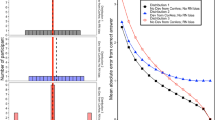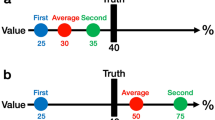Abstract
This paper investigates how communication influences people’s judgment quality in simple estimation tasks. Except for an exchange of estimates, our design also allows the exchange of supportive evidence underlying the estimates in a controlled manner. Compared with the control treatment, the exchange of estimates and supportive evidence together improves judgment quality at both the individual level and the crowd level. On the other hand, the exchange of estimates or supportive evidence separately has no impact.


Similar content being viewed by others
Notes
It is 10% of the true value.
This finding is robust to different thresholds: \(l=0.2\) and \(l=0.4\).
The answers to these tasks are: 48, 64, 29, 18, 1191, 53, 772, 87, 30, 44, 787, 37, 768, 34, 21.
References
Baillon, A., Bleichrodt, H., Liu, N., & Wakker, P. P. (2016). Group decision rules and group rationality under risk. Journal of Risk and Uncertainty, 52(2), 99–116.
Beer, A. (2013). Group personality judgments at zero acquaintance: Communication among judges versus aggregation of independent evaluations. Journal of Research in Personality, 47(4), 385–389.
Bolger, F., & Rowe, G. (2015). The aggregation of expert judgment: Do good things come to those who weight? Risk Analysis, 35(1), 5–11.
Bonaccio, S., & Dalal, R. S. (2006). Advice taking and decision-making: An integrative literature review, and implications for the organizational sciences. Organizational Behavior and Human Decision Processes, 101(2), 127–151.
Burchardi, K. B., & Penczynski, S. P. (2014). Out of your mind: Eliciting individual reasoning in one shot games. Games and Economic Behavior, 84, 39–57.
Cameron, A. C., Gelbach, J. B., & Miller, D. L. (2012). Robust inference with multiway clustering. Journal of Business and Economic Statistics, 29, 238–249.
Charness, G., & Grosskopf, B. (2004). What makes cheap talk effective? Experimental evidence. Economics Letters, 83(3), 383–389.
Chen, C. (2007). Holistic sense-making: conflicting opinions, creative ideas, and collective intelligence. Library Hi Tech, 25(3), 311–327.
Coleman, S., & Blumler, J. G. (2011). The wisdom of which crowd? On the pathology of a listening government. The Political Quarterly, 82(3), 355–364.
Deci, E. L., Koestner, R., & Ryan, R. M. (1999). A meta-analytic review of experiments examining the effects of extrinsic rewards on intrinsic motivation. Psychological bulletin, 125(6), 627.
Deutsch, M., & Gerard, H. B. (1955). A study of normative and informational social influences upon individual judgment. The Journal of Abnormal and Social Psychology, 51(3), 629–636.
Farrell, S. (2011). Social influence benefits the wisdom of individuals in the crowd. Proceedings of the National Academy of Sciences, 108(36), E625–E625.
Farrell, J., & Rabin, M. (1996). Cheap talk. Journal of Economic perspectives, 10(3), 103–118.
Festré, A., & Garrouste, P. (2015). Theory and evidence in psychology and economics about motivation crowding out: A possible convergence? Journal of Economic Surveys, 29(2), 339–356.
Galton, F. (1907). Vox Populi. Nature, 75(1949), 450–451.
Heath, C., & Gonzalez, R. (1995). Interaction with others increases decision confidence but not decision quality: Evidence against information collection views of interactive decision making. Organizational Behavior and Human Decision Processes, 61(3), 305–326.
Jenness, A. (1932). The role of discussion in changing opinion regarding a matter of fact. The Journal of Abnormal and Social Psychology, 27(3), 279–296.
Kerr, N. L., & Tindale, R. S. (2004). Group performance and decision making. Annual Review of Psychology, 55, 623–655.
Krause, J., Ruxton, G. D., & Krause, S. (2010). Swarm intelligence in animals and humans. Trends in Ecology and Evolution, 25(1), 28–34.
Larrick, R., Mannes, A., & Soll, J. B. (2011). The social psychology of the wisdom of crowds (pp. 227–242). Philadelphia: Psychology Press.
Laughlin, P. R., Hatch, E. C., Silver, J. S., & Boh, L. (2006). Groups perform better than the best individuals on letters-to-numbers problems: Effects of group size. Journal of Personality and Social Psychology, 90(4), 644–651.
Lee, J.-H., & Chang, M.-L. (2010). Stimulating designers’ creativity based on a creative evolutionary system and collective intelligence in product design. International Journal of Industrial Ergonomics, 40(3), 295–305.
Loewenstein, G., & Moore, D. A. (2004). When ignorance is bliss: Information exchange and inefficiency in bargaining. The Journal of Legal Studies, 33(1), 37–58.
Lord, C. G., Ross, L., & Lepper, M. R. (1979). Biased assimilation and attitude polarization: The effects of prior theories on subsequently considered evidence. Journal of Personality and Social Psychology, 37(11), 2098–2109.
Lorenz, J., Rauhut, H., Schweitzer, F., & Helbing, D. (2011). How social influence can undermine the wisdom of crowd effect. Proceedings of the National Academy of Sciences, 108(22), 9020–9025.
Lykourentzou, I., Papadaki, K., Vergados, D. J., Polemi, D., & Loumos, V. (2010). CorpWiki: A self-regulating wiki to promote corporate collective intelligence through expert peer matching. Information Sciences, 180(1), 18–38.
Maciejovsky, B., Sutter, M., Budescu, D. V., & Bernau, P. (2013). Teams make you smarter: How exposure to teams improves individual decisions in probability and reasoning tasks. Management Science, 59(6), 1255–1270.
Mannes, A. E. (2009). Are we wise about the wisdom of crowds? The use of group judgments in belief revision. Management Science, 55(8), 1267–1279.
Nguyen, N. T. (2008). Inconsistency of knowledge and collective intelligence. Cybernetics and Systems, 39(6), 542–562.
Penczynski, S. P. (2016). Persuasion: An experimental study of team decision making. Journal of Economic Psychology, 56, 244–261.
Pentland, A. (2007). On the collective nature of human intelligence. Adaptive Behavior, 15(2), 189–198.
Plous, S. (1991). Biases in the assimilation of technological breakdowns: Do accidents make us safer? Journal of Applied Social Psychology, 21(13), 1058–1082.
Linstone, H. A., & Turoff, M. (Eds.). (1975). Delphi Method: Techniques and Applications. Reading: Addison-Wesley.
Sah, S., Moore, D. A., & MacCoun, R. J. (2013). Cheap talk and credibility: The consequences of confidence and accuracy on advisor credibility and persuasiveness. Organizational Behavior and Human Decision Processes, 121(2), 246–255.
Schotter, A., & Sopher, B. (2007). Advice and behavior in intergenerational ultimatum games: An experimental approach. Games and Economic Behavior, 58(2), 365–393.
Soll, J. B., & Larrick, R. P. (2009). Strategies for revising judgment: How (and how well) people use others’s opinions. Journal of Experimental Psychology Learning, Memory, and Cognition, 35(3), 780–805.
Soll, J. B., & Mannes, A. E. (2011). Judgmental aggregation strategies depend on whether the self is involved. International Journal of Forecasting, 27(1), 81–102.
Stroop, J. R. (1932). Is the judgment of the group better than that of the average member of the group? Journal of Experimental Psychology, 15(5), 550–562.
Surowiecki, J. (2005). The Wisdom of Crowds. New York: Knopf Doubleday Publishing Group.
Wagner, C., & Vinaimont, T. (2010). Evaluating the wisdom of crowds. Proceedings of Issues in Information Systems, 11(1), 724.
Yaniv, I., & Kleinberger, E. (2000). Advice taking in decision making: Egocentric discounting and reputation formation. Organizational Behavior and Human Decision Processes, 83(2), 260–281.
Acknowledgements
We would like to thank the coordinating teachers at the participating schools for making this study possible. We received helpful comments from Peter Wakker, Amit Kothiyal and seminar participants from the Center for Adaptive Behavior and Cognition at Max Planck Institution. Financial supports from Tinbergen Institution and the Econometrics Institute at Erasmus School of Economics are gratefully acknowledged. Ning Liu acknowledges financial support from the European Research Council under the European Community’s Programme“Ideas”—Call identifier: ERC-2013-StG/ERC grant agreement No. 336703, project RISICO “RISk and uncertainty in developing and Implementing Climate change pOlicies”. Chen Li would like to acknowledge the financial support from the Veni grant of the Netherlands Organization for Scientific Research (N.W.O.) and the EUR fellowship of the Erasmus University Rotterdam.The funding sources had no involvement in the study design, collection of data or the decision to submit the article for publication.
Author information
Authors and Affiliations
Corresponding author
Additional information
Publisher's Note
Springer Nature remains neutral with regard to jurisdictional claims in published maps and institutional affiliations.
Appendices
Appendix 1: Questionnaire
1.1 The ESQ
There are in total 15 questionsFootnote 3. Please make sure you have answered all the questions before handing in the questionnaire.
-
1
___________ countries in the Asia.
-
2
There are in total ___________ triangles in Fig. 3.
-
3
There are in total ___________ triangles in Fig. 4.
-
4
Feng Xiaogang has so far directed ___________ movies.
-
5
Romance of the Three Kingdoms has in total ___________characters.
-
6
Yang Mi has so far starred in ___________different movies and TV dramas.
-
7
Harry Potter (book series) has in total ___________characters.
-
8
China has won in total ___________medals at the 2012 Summer Olympics in London.
-
9
There are currently in total ___________ NBA teams.
-
10
There are currently in total ___________countries in Europe.
-
11
Water Margin has in total ___________characters.
-
12
Tom Cruise has so far starred in ___________different movies.
-
13
Dream of the Red Chamber has in total ___________characters.
-
14
Zhao Wei has so far starred in ___________different movies and TV dramas.
-
15
Zhang Yimou has so far directed ___________movies.
1.2 The EVQ

Appendix 2: instructions
Thank you for your participation. This experiment consists of two stages.
During the first stage, you will fill in questionnaire 1 and also write down your answers on a separate answer sheet. You have 25 min to complete this stage, after which the experimenter will collect the questionnaire 1 and the answer sheet.
During the second stage, you will receive questionnaire 2 AND one of your classmates’ answer sheets from the previous stage. When filling in questionnaire 2, you can refer to the answer sheet you received. You have 10 min to finish stage 2. Afterwards, the experimenter will collect all documents and proceed to the payment procedure.
Payment procedure
Please fill the subject ID assigned to you in the top left corner blank on both questionnaires and answer sheets. Questionnaires without a subject ID will not be paid. At the end of the experiment, we will randomly draw eight subject numbers. Students with the eight numbers will be paid according to the accuracies of their answer. Others will receive ten RMB show-up fee. Each student has an equal probability to be drawn.
In case your subject ID is drawn, please go to the payment desk, where you will randomly draw a question number from the 30 questions (15 on Questionnaire 1 and 15 on Questionnaire 2). The experimenter will reveal the correct answer to the question drawn and your payment will be determined as follows:
Your prize is 100 RMB if your answer is within the 5% interval around the correct answer.
Your prize is 50 RMB if your answer is within the 10% interval but out of the 5% interval around the correct answer.
Your prize is 20 RMB if your answer is within the 20% interval but out of the 10% interval around the correct answer.
Your prize is ten RMB if your answer is out of the 20% interval around the correct answer.
No communication is allowed during the experiment. Students who talk with others will be disqualified from the experiment.
Appendix 3: evidence response results


Appendix 4: direct comparisons of accuracy and confidence at the two stages
Rights and permissions
About this article
Cite this article
Li, C., Liu, N. What to tell? Wise communication and wise crowd. Theory Decis 90, 279–299 (2021). https://doi.org/10.1007/s11238-020-09784-y
Accepted:
Published:
Issue Date:
DOI: https://doi.org/10.1007/s11238-020-09784-y






